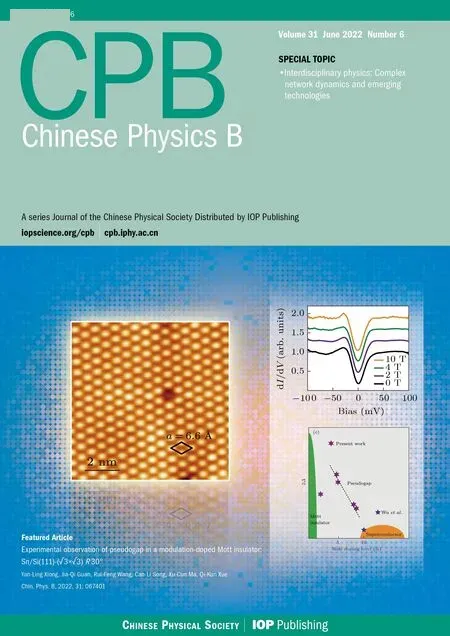Magnetic and magnetocaloric effect in a stuffed honeycomb polycrystalline antiferromagnet GdInO3
2022-06-29YaoDongWu吴耀东WeiWeiDuan段薇薇QiuYueLi李秋月YongLiangQin秦永亮ZhenFaZi訾振发andJinTang汤进
Yao-Dong Wu(吴耀东) Wei-Wei Duan(段薇薇) Qiu-Yue Li(李秋月) Yong-Liang Qin(秦永亮)Zhen-Fa Zi(訾振发) and Jin Tang(汤进)
1Universities Joint Key Laboratory of Photoelectric Detection Science and Technology in Anhui Province,Anhui Province Key Laboratory of Simulation and Design for Electronic Information System,and School of Physics and Materials Engineering,Hefei Normal University,Hefei 230601,China
2Anhui Province Key Laboratory of Condensed Matter Physics at Extreme Conditions,High Magnetic Field Laboratory,HFIPS,Anhui,Chinese Academy of Sciences,Hefei 230031,China
3University of Science and Technology of China,Hefei 230026,China
Keywords: GdInO3,magnetization,magnetocaloric effects,stuffed honeycomb antiferromagnet
1. Introduction
With the increasingly severe issues of global warming and the energy crisis, the magnetic refrigeration (MR) technique based on the magnetocaloric effect (MCE) of magnetic materials has revealed superior advantages such as higher energy efficiency, a more robust design, and greater environmental friendliness compared to the conventional gascompression refrigerant methods by using ozone consuming volatile refrigerants.[1–3]The search for high-performance magnetocaloric materials has significant meaning in the future applications of the MR technique at room temperature for domestic and industrial purposes,[4,5]with the representative compounds such as Gd metal,[6]La(Fe,Si),[5]Gd5(SiGe)4,[7]MnFe(P, As),[8]FeRh,[9]and LaAMnO3(A= Ca2+, Ba2+,Na+, K+, and so on).[10–13]In addition, it is important to explore magnetocaloric materials at the cryogenic temperature,which would be beneficial for hydrogen or helium liquefaction and space science.[5,14]Over the past few decades,attention has mostly been paid to cryogenic magnetocaloric materials with rare-earth based alloys and oxides,such as Gd3B5O12(B=Ga, Fe, Al),[15]RM2(R=rare earth elements,M=Al,Ni, Co),[16–18]RM(M=Zn, Ga),[19–22]RMX(M=Fe, Co,X=Al, Mg, C),[23,24]R2T2X(T=Cu, Ni, Co,X=In, Al,Ga, Sn, and so on),[25]R60Co20Ni20(R= Ho and Er),[26]La1-xPrxFe12B6,[27]Gd20Ho20Tm20Cu20Ni20,[28]DyNiGa,[2]dual-phase HoNi/HoNi2composite,[29]RNO3(N= Al, Fe,Mn, Cr, and so on),[30–37]andR2M2O7.[38–42]In particular,recent studies have demonstrated that the Gd3+and Eu2+ion-based compounds display great MCE performances due to the large angular momentum of the half-filled 4f shell(4f7) and negligible crystal electrical field (CEF) effect withJ=S= 7/2,L= 0, with the representative compounds such as GdFeO3,[43]GdScO3,[44]GdCrO3,[45]GdAlO3,[46]GdVO4,[47,48]GdPO4,[49]GdBO3,[50]and EuTiO3.[51,52]
In contrast to the conventional magnetic systems with long range ferromagnetic (FM) or antiferromagnetic (AFM)ordering, geometrically frustrated magnets possess peculiar lattice structures,leading to a competition between the neighboring spin–spin interactions. Exotic magnetic properties such as spin ice and the spin liquid state can be expected in geometrically frustrated magnets with Kagome, garnet,and pyrochlore lattices.[53]As a result, disordered cooperative paramagnetic ground states can remain even at temperatures much lower than the paramagnetic Curie–Weiss temperatureθw. Many geometrically frustrated magnets have been reported to possess considerable magnetocaloric performances in cryogenic temperature regions, since the quasiparamagnetic ground states in these systems contribute no reduced entropy, which can hinder the temperature change in the adiabatic demagnetization process.[53]The typical cases are antiferromagnetR2M2O7(M= Ti, Mo) with pyrochlore lattices,[39,40,42,54]Gd3Ga5O12with garnet lattice,[55]R3BWO9with distorted kagome magnetic lattices,[56,57]and SrGd2O4with distorted honeycomb magnetic lattices,[58]as well as TmMgGaO4,[59]RBO3,[50]and Ba3Ln(BO3)3(Ln=Ho–Lu)with two-dimensional(2D)triangular magnetic lattices.[60]
Rare-earth indium oxidesRInO3possess three main types of crystal structures.[61]As the radius of rare earth ions decreases, the crystal structures can be orthorhombic with the space groupPnma(forR= La, Pr, Nd, and Sm), hexagonal with the space groupP63cm(forR= Sm–Ho, Y),or cubic with the space groupIa¯3 (forR= Ho, Er, Yb).HexagonalRInO3displays fascinating properties such as pressure induced hexagonal to orthorhombic crystal structure transformation,[62]geometric multiferroic behavior,[63]and negative thermal expansion.[64]Notably, the crystal structure of hexagonalRInO3consists of 2D triangular layers ofR3+ions separated by non-magnetic layers of corner-sharing[InO5] trigonal bipyramids,[65]as shown in Fig. 1(a). This unique magnetic lattice,also called the stuffed honeycomb lattice,is formed by two nonequivalent rare-earthR3+sites with theR1 ions in the honeycomb sites andR2 at the center of each hexagon (see Fig. 1(b)).[66]If the anisotropic antiferromagnetic interactions caused by spin–orbit coupling exist between the twoR3+sites, also known as bond-dependent Kitaev interactions, a frustrated spin liquid ground state without long range magnetic ordering can be expected in the honeycomb magnetic system.[67,68]As one crucial member of hexagonalRInO3, TbInO3has recently been revealed to be a highly frustrating spin liquid magnetic system with a stuffed Tb3+ion-based honeycomb lattice,[67,69]which is very extraordinary because the previous studies on spin-1/2 honeycomb magnets have focused mostly on the 4d and 5d transition metal systems such asα-RuCl3,[70,71]and the A2IrO3iridates.[72,73]Similarly,it has been reported that GdInO3possesses no long-range magnetic ordering down to temperatures as low as 1.8 K, indicating magnetic frustrated characters at low temperatures.[64,74]However,more thorough studies with various experimental and theoretical methods need to be conducted to uncover the magnetic structure at the ground state.
In this article,the magnetic and MCE are studied in polycrystalline GdInO3. The sharp upturn and the negative Curie–Weiss temperature indicate the onset of antiferromagnetic ordering belowTN~2.1 K in GdInO3. Negligible thermal and magnetic hysteresis indicate a reversible MCE. For the magnetic field changes of 0 kOe–50 kOe and 0 kOe–70 kOe, the maximum magnetic entropy change values are 9.65 J/kg·K and 18.37 J/kg·K,respectively,near the liquid helium temperature,with the corresponding relative cooling power(RCP)values of 115.01 J/kg and 211.31 J/kg. The large reversible MCE of polycrystalline GdInO3will provide another avenue for magnetocaloric refrigerant exploitation in frustrated magnetic systems near the cryogenic temperature region and will aid in understanding the exotic magnetic properties of the frustrated magnetic ground state in stuffed honeycomb antiferromagnet GdInO3.
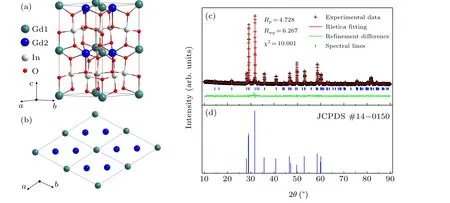
2. Experiments
The GdInO3powders were synthesized with the conventional solid-state reaction method. High purity Gd2O3(99.99%, General Research Institute for Nonferrous Metals)and In2O3(99.99%,GRINM)powders were thoroughly mixed in an equimolar amount and heated at 1673 K for 72 h with several intermediate grindings. A Rigaku Miniflex 624 x-ray diffractometer was used to carefully check the phase purities and crystal structures of the powders with high-intensity graphite monochromatized CuKαradiation at the room temperature. The Rietveld refinement of the x-ray diffraction(XRD)pattern was carried out by using Rietica software. The temperature and the magnetic field dependences of the magnetizations were measured for powder samles with masses of~2.6 mg by a Quantum Design superconducting quantum interference device vibrating sample magnetometer (SQUIDVSM)within the temperature range of 1.8 K–300 K.
3. Results and discussion
The XRD measurement was carried out to confirm the phase purity of the synthesized powder. Figure 2(c) displays the room-temperature powder XRD pattern of the synthesized sample with Rietveld refinement. The sample exhibits a hexagonal structure with aP63cm(No. 185) space group with refinement factors ofRp=4.728 andRwp=6.267, and no impurity was detected.All the diffraction peaks in the XRD pattern coincide with the spectral lines of the GdInO3standard card(No.14-0150)in the Joint Committee on Powder Diffraction Standards (JCPDS) database as shown in Fig. 2(d). The refined lattice parametersa=6.3569 andc=12.3512 agree well with the previously reported values.[74]
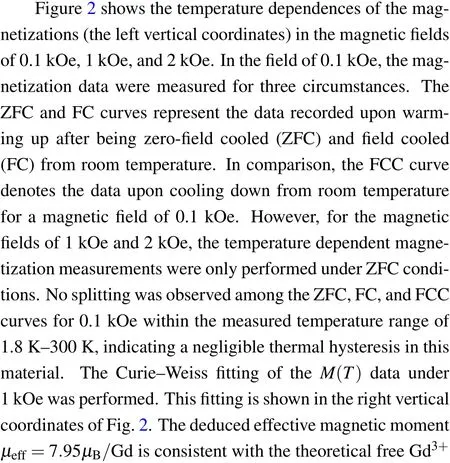
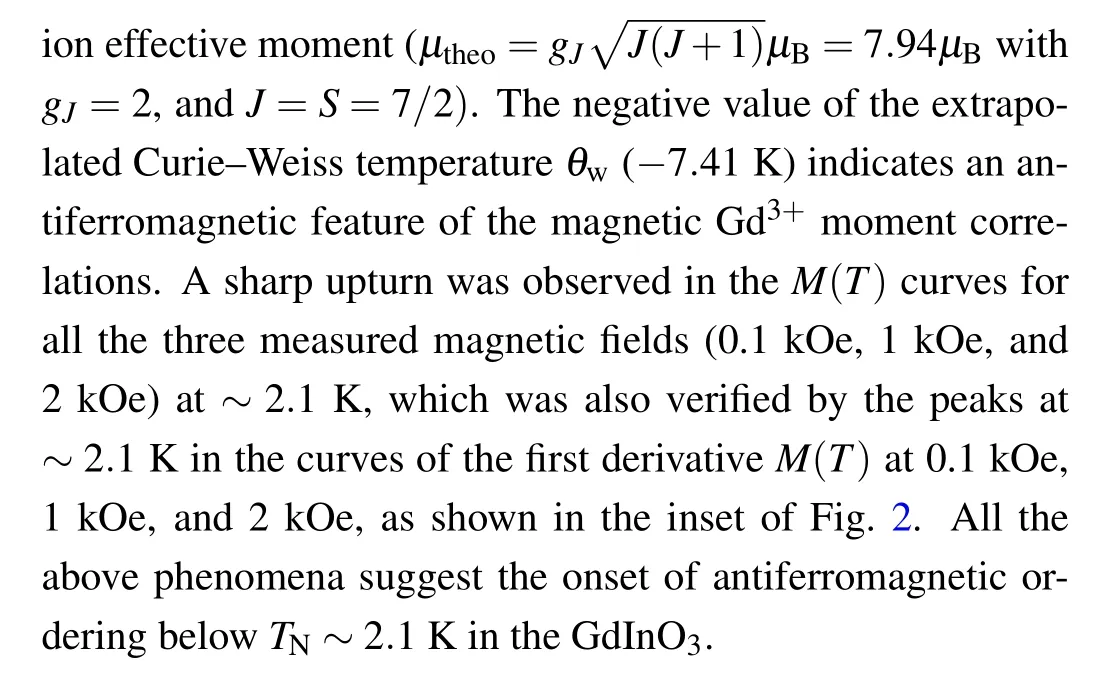
The magnetic field dependent magnetization hysteresis loops(M–H)and∂M/∂Hcurves at 1.8 K and 10 K are shown in Fig. 3. The absence of hysteresis indicates a reversible MCE.With the increase of the magnetic field,the growth rate of the magnetizations at 1.8 K undergoes the first declining tendency in the magnetic field region of 0 kOe–28 kOe, followed by a rising tendency in the 28 kOe–46 kOe field region,and then a second declining tendency in the 46 kOe–70 kOe field region. Correspondingly, we observed the anomalies in theM–Hhysteresis loop at±28 kOe with the magnetization value of 2.081μB/f.u.(~0.26 times theμtheovalue of the free Gd3+moment). This can be understood as theMs/3 phenomenon induced by the collinear“up–up–down”arrangement of the Gd3+moments in the external magnetic field of the 2D triangular lattices. Similar results were also reported in other geometrically frustrated systems with 2D triangular magnetic lattices.[75–78]However,the growth rate of the magnetizations at 10 K has a declining tendency in the entire measured magnetic field range of 0 kOe–70 kOe, which demonstrates that the magnetic field induced transition is suppressed by the thermal fluctuation at high temperatures. At 1.8 K,the magnetization value reaches 4.81μB/f.u.(107.47 emu/g)at 70 kOe, which corresponds to only~60.5% of the expected theoretical Gd3+ion magnetic moments(7.94μB/f.u.).The isothermal magnetization curves in the temperature range of 2 K–60 K are shown in Fig. 4(a). Compared to the other reported Gd3+-based compounds such as GdScO3,[44]GdFeO3,[79]and GdCoO3,[80]the field dependent magnetizations of GdInO3reveal a slower growth rate and much lower values at the same magnetic fields. Even at a low temperature of 2 K and a high magnetic field of 70 kOe, no saturation value of the magnetization was observed. The above phenomena can be attributed to the stuffed honeycomb lattice induced magnetic frustrations. Based on the isothermal magnetizations shown in Fig.4(a), the Arrott plot of GdInO3was obtained,as shown in Fig.4(b). All the data lines display positive slopes, which confirm a second-order characteristic of magnetic field induced magnetic transition according to the Banerjee criterion.[81]


Considering the prominent field dependent magnetizations with negligible thermal and magnetization hysteresis,there can be an expectation of a large reversible MCE in polycrystalline GdInO3. By using the Maxwell relationship, the magnetic entropy changes-ΔSMwere calculated based on theM–Hdata,as shown in the following equation:[5]
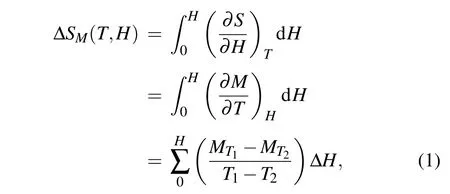
whereMT1andMT2represent the magnetizations at temperaturesT1andT2, respectively, for a magnetic field change of ΔH. Figure 5(a) shows the temperature dependences of the magnetic entropy changes in GdInO3. The maximums of the magnetic entropy changes lie in the temperature below 5 K within all the measured magnetic field region,which then shift to higher temperatures with the increasing magnetic field change. Only the hot half parts of-ΔSMpeaks are observed, which may have been attributed to the highly geometrical frustrated magnetic lattices in GdInO3. In the magnetic field changes of 0 kOe–20 kOe, 0 kOe–50 kOe, and 0 kOe–70 kOe, the maximum magnetic entropy values are 3.94 J/kg·K at 2.5 K,9.65 J/kg·K at 3.5 K,and 18.37 J/kg·K at 3.5 K,respectively. Additionally,the other two crucial parameters used to estimate the MCE performance are the refrigerant capacity (RC) and the relative cooling power (RCP). For convenience, these parameters are calledRfactors in this paper,and are defined as follows:[82]
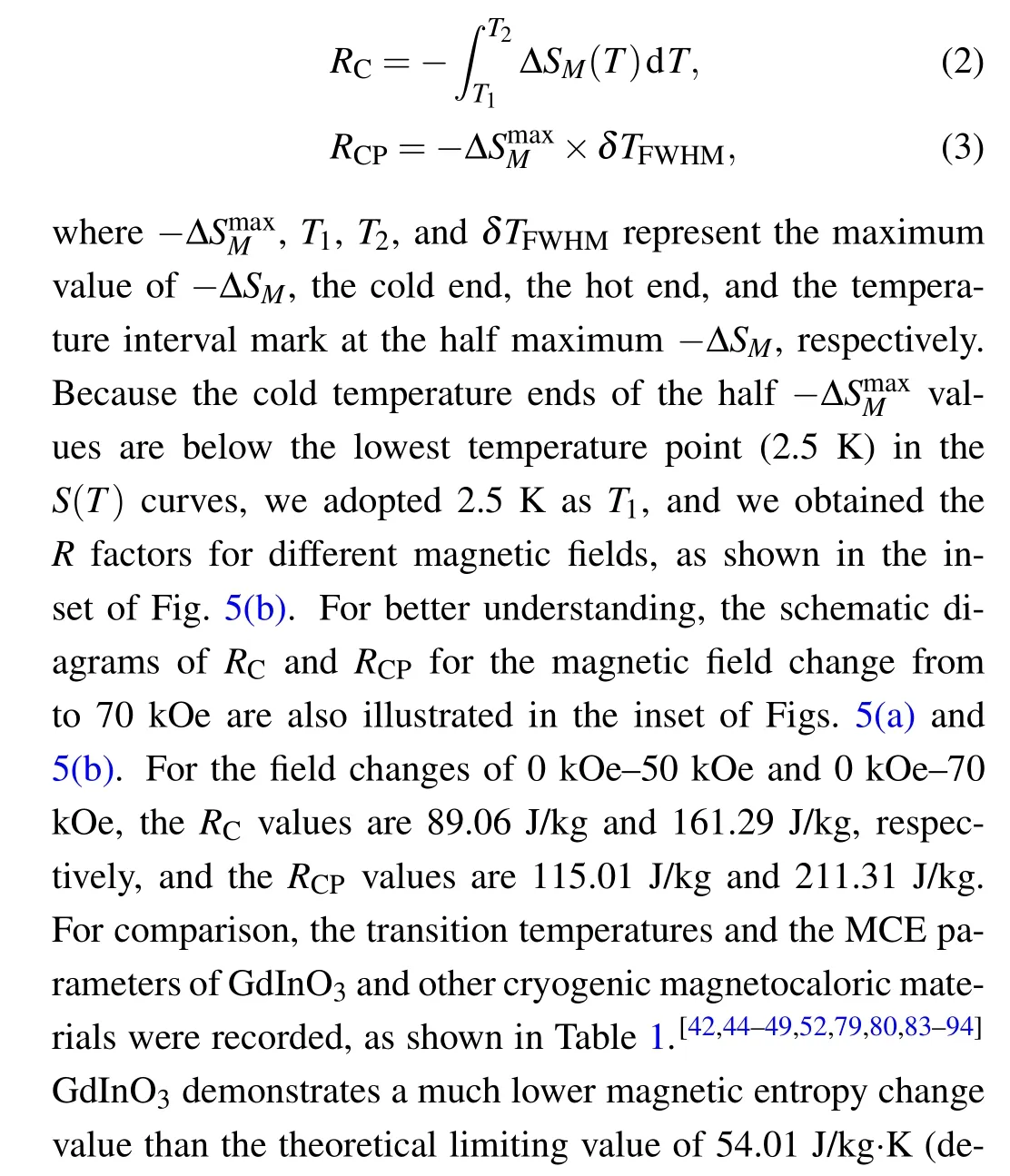

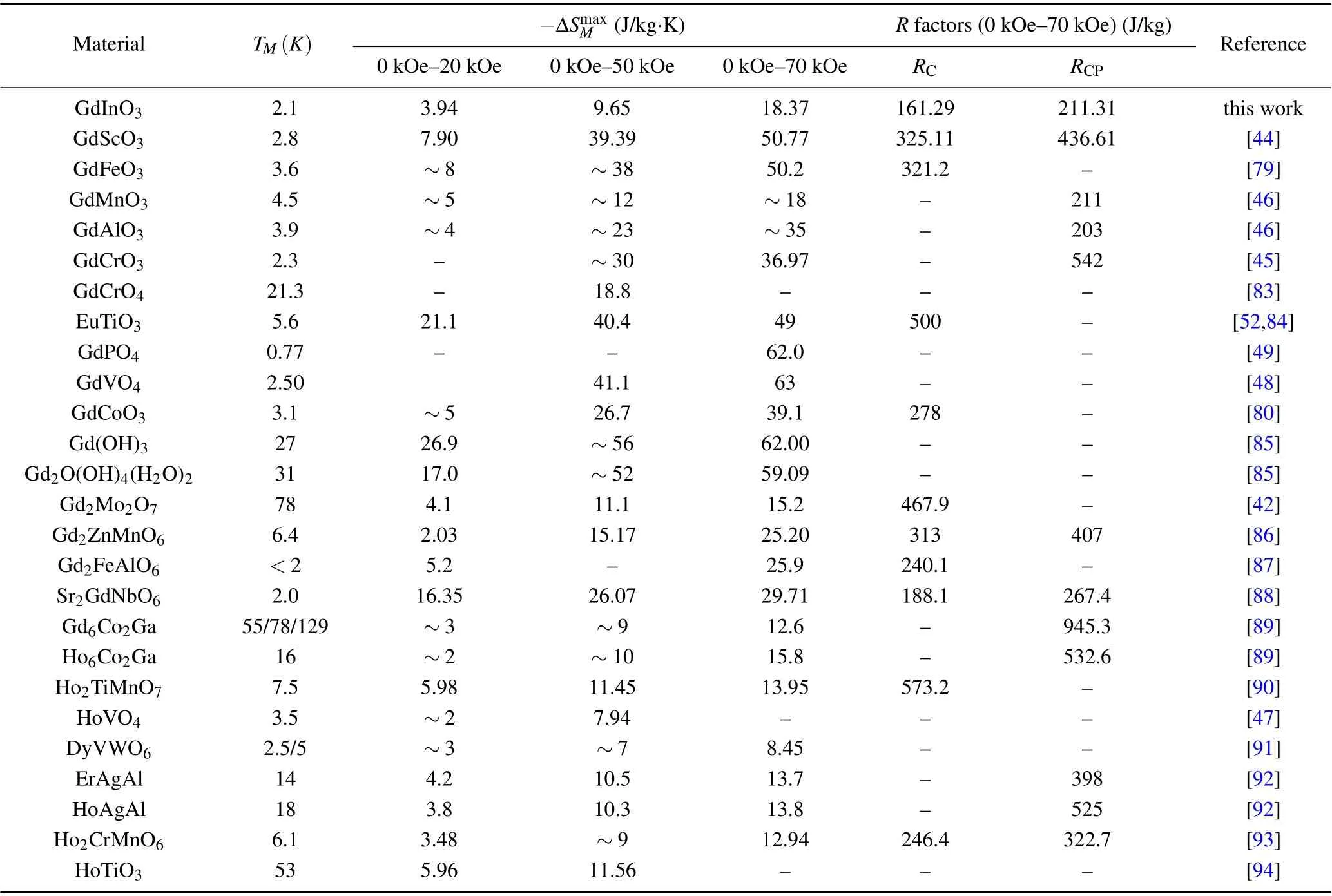
Material TM(K) -ΔSmax M (J/kg·K) R factors(0 kOe–70 kOe)(J/kg) Reference 0 kOe–20 kOe 0 kOe–50 kOe 0 kOe–70 kOe RC RCP GdInO3 2.1 3.94 9.65 18.37 161.29 211.31 this work GdScO3 2.8 7.90 39.39 50.77 325.11 436.61 [44]GdFeO3 3.6 ~8 ~38 50.2 321.2 – [79]GdMnO3 4.5 ~5 ~12 ~18 – 211 [46]GdAlO3 3.9 ~4 ~23 ~35 – 203 [46]GdCrO3 2.3 – ~30 36.97 – 542 [45]GdCrO421.3–18.8–––[83]EuTiO35.621.140.449500–[52,84]GdPO40.77– –62.0– –[49]GdVO42.50 41.163––[48]GdCoO3 3.1 ~5 26.7 39.1 278 – [80]Gd(OH)3 27 26.9 ~56 62.00 – – [85]Gd2O(OH)4(H2O)231 17.0 ~52 59.09 – – [85]Gd2Mo2O7784.111.115.2467.9–[42]Gd2ZnMnO6 6.4 2.03 15.17 25.20 313 407 [86]Gd2FeAlO6 <2 5.2 – 25.9 240.1 – [87]Sr2GdNbO6 2.0 16.35 26.07 29.71 188.1 267.4 [88]Gd6Co2Ga 55/78/129 ~3 ~9 12.6 – 945.3 [89]Ho6Co2Ga 16 ~2 ~10 15.8 – 532.6 [89]Ho2TiMnO77.55.9811.4513.95573.2–[90]HoVO4 3.5 ~2 7.94 – – – [47]DyVWO6 2.5/5 ~3 ~7 8.45 – – [91]ErAgAl144.210.513.7–398[92]HoAgAl183.810.313.8–525[92]Ho2CrMnO6 6.1 3.48 ~9 12.94 246.4 322.7 [93]HoTiO3535.9611.56–––[94]
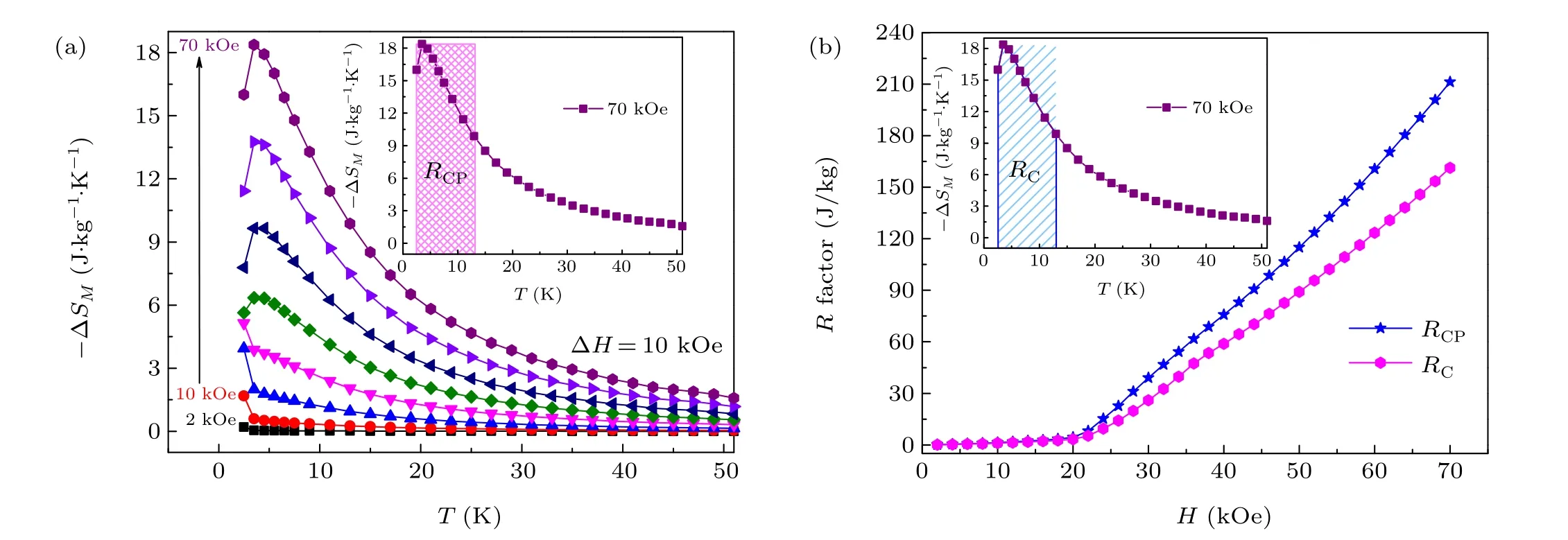
4. Conclusion
In summary, we performed the magnetic and magnetocaloric investigations of polycrystalline GdInO3. The onset of antiferromagnetic ordering was observed atTN~2.1 K.The magnetization value of only 60.5% of free Gd3+moments at 1.8 K and 70 kOe reveals frustration in this stuffed honeycomb antiferromagnet system. No thermal and magnetization hysteresis was observed, which indicates a reversible MCE performance. In the magnetic field changes of 0 kOe–50 kOe and 0 kOe–70 kOe, the maximum magnetic entropy changes of 9.65 J/kg·K and 18.37 J/kg·K, respectively, were obtained near the liquid helium temperature. Correspondingly, theRCvalues are 89.06 J/kg and 161.29 J/kg,and theRCPvalues are 115.01 J/kg and 211.31 J/kg. The relatively lower maximum magnetic entropy changes of GdInO3compared to the theoretical changes may be owing to the triangular-honeycomb magnetic Gd3+lattice caused magnetic frustration. The MCE performance is expected to facilitate understanding of the frustrated magnetic interactions in stuffed honeycomb antiferromagnet GdInO3.
Acknowledgments
Project supported by the National Natural Sciences Foundation of China (Grant Nos. 12104123 and U1632161),Anhui Provincial Funds for Distinguished Young Scientists of the Nature Science (Grant No. 1808085JQ13),the Natural Science Foundation of Anhui Province (Grant No. 2008085MF217), Universities Joint Key Laboratory of Photoelectric Detection Science and Technology in Anhui Province (Grant No. 2019GDTC06), the open fund project from Anhui Province Key Laboratory of Simulation and Design for Electronic Information System (Grant No.2019ZDSYSZY04),the Project of Leading Backbone Talents in Anhui Provincial Undergraduate Universities,and Undergraduate Innovation and Entrepreneurship Training Program in Anhui Province(Grant No.S202014098164).
杂志排行
Chinese Physics B的其它文章
- Switchable terahertz polarization converter based on VO2 metamaterial
- Data-driven parity-time-symmetric vector rogue wave solutions of multi-component nonlinear Schr¨odinger equation
- Neutron activation cross section data library
- Multi-phase field simulation of competitive grain growth for directional solidification
- A novel similarity measure for mining missing links in long-path networks
- Effects of electrical stress on the characteristics and defect behaviors in GaN-based near-ultraviolet light emitting diodes
